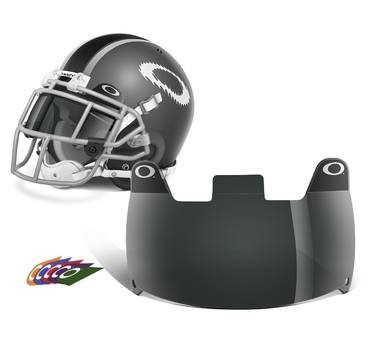 Two of the most popular brands of football helmet faceshields can withstand a hit equivalent to a kick in the face and provide that protection without disrupting players' vision, according to a recent study published in the journal Optometry.
Two of the most popular brands of football helmet faceshields can withstand a hit equivalent to a kick in the face and provide that protection without disrupting players' vision, according to a recent study published in the journal Optometry.
The eye specialists at Ohio State University used an air cannon to hurl baseballs at the plastic faceshields. The impact was designed to mimic the force of a kick to the face, considered the riskiest way to sustain an eye injury in football.
Should faceshields be mandatory?
The faceshields' protective potential bolsters an argument favoring mandatory use of the shields for college-age football players and younger, said Gregory Good, professor of clinical optometry at Ohio State and a co-author of the study. Collegiate programs currently do not mandate their use.
"I think this would be a good idea not only from a collegiate standpoint, but all the way down to peewee football, especially for players with good vision in only one eye," Good said. "Players in the pros can make their own decisions, but it would be helpful to have coaches and managers on board to convince kids in high school and younger kids especially to wear faceshields. At that age, kids typically don't have enough experience to make a decision about safety on their own."
The study tested the two most popular collegiate and professional football helmet faceshields by manufacturers Oakley, based in Foothills Ranch, Calif., and Nike, based in Beaverton, Oregon. The companies donated faceshields for use in the study. The average cost is $45 to $50 per shield.
Eye injuries in football
Though serious eye injuries in football are relatively rare, the researchers mentioned the case of Orlando Brown of the Cleveland Browns, whose eye was inadvertently hit by a referee's thrown penalty flag during a game in 1999. He missed several seasons after the injury.
A summary of National Electronic Injury Surveillance System data shows that about one-third of football-related eye injuries documented between 2002 and 2006 were caused by the football itself and almost one-fifth were from finger pokes. The data do not specify whether these injuries occurred during organized games or "street" play. Other data also show in 2000, U.S. emergency rooms treated an estimated 40,000 sports-related eye injuries.
And more than 10 years ago, the sports safety committees of the American Academy of Pediatrics and the American Academy of Ophthalmology issued a report recommending that football helmets be equipped with a polycarbonate faceshield for face and eye protection. They were responding to a 1993 report by Prevent Blindness America indicating that football was the fifth-greatest contributor to sports-related eye injuries in patients younger than 25.
Source: Ohio State University
Want to discuss this article or have a question answered? Join us in the forums!








